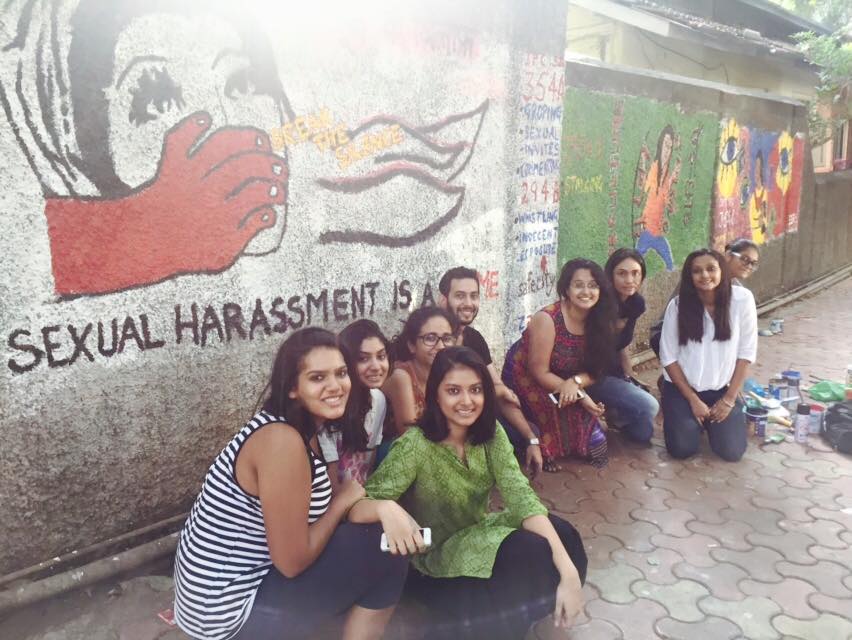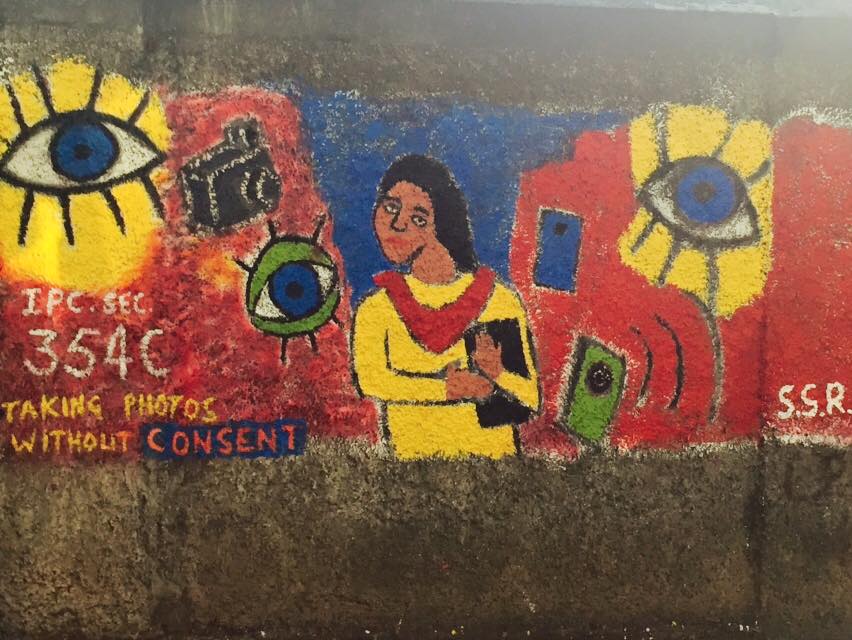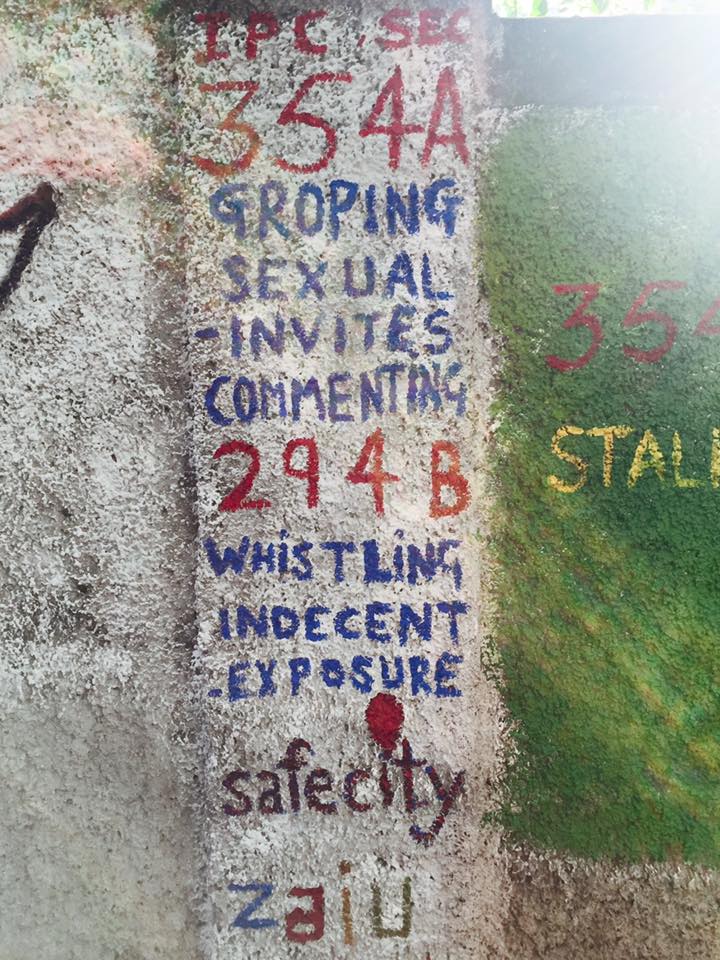Safecity and students in Mumbai painted the #TalkingWall along Peddar Road, outside Sophia College.
#16Days of Activism: Raising Awareness on Campuses (Day 12)
Nov. 25 – Dec. 10 are the 16 Days of Activism Against Gender-Based Violence. To commemorate the week, we are featuring 1 activism idea per day. This information is excerpted from my new book Stop Global Street Harassment: Growing Activism Around the World (Praeger 2015).
A growing number of colleges and universities from Egypt to the United States have been addressing street harassment, often during Sexual Assault Awareness Month or in conjunction with International Women’s Day or International Anti-Street Harassment Week. They host workshops and street demonstrations, write sidewalk chalk messages, distribute materials, screen documentaries like the 1998 film War Zone, and create their own videos.
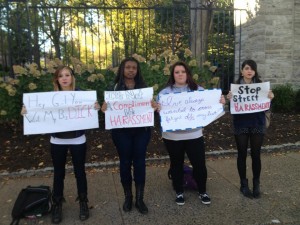 In 2012, members of Pennsylvania State University’s Triota, the women’s studies honor society, held an anti-street harassment demonstration on a busy Friday afternoon in October in downtown State College, Pennsylvania. They held signs proclaiming their anti-harassment message and even included specific remarks that had been yelled at them during their time at Penn State like “Hey girl, you want my big dick?” and “I’ve always wanted to cross a fat girl off my list.” They also held up anti-street harassment messages like “It’s not a compliment; it’s harassment.” Julie Mastrine, one of the organizers, wrote about it for the SSH blog:
In 2012, members of Pennsylvania State University’s Triota, the women’s studies honor society, held an anti-street harassment demonstration on a busy Friday afternoon in October in downtown State College, Pennsylvania. They held signs proclaiming their anti-harassment message and even included specific remarks that had been yelled at them during their time at Penn State like “Hey girl, you want my big dick?” and “I’ve always wanted to cross a fat girl off my list.” They also held up anti-street harassment messages like “It’s not a compliment; it’s harassment.” Julie Mastrine, one of the organizers, wrote about it for the SSH blog:
Don’t be mistaken: these types of incidents aren’t rare in this town. Street harassment is a widespread problem in State College, where nearly every woman I know has experienced some form of it: catcalls, taunting, lewd remarks, leering, sexually objectifying remarks, you name it. And this type of harassment functions as part of a larger issue in this town: rape culture. We saw a lot of stares and furrowed brows from passersby. Only a few people approached us to express their support, but it doesn’t matter—getting this issue in the eyes and ears of the State College community is important if we want to combat harmful behavior and attitudes toward women.
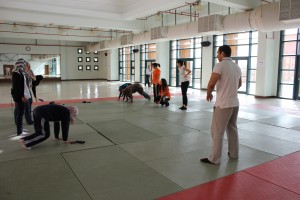 In Egypt, college student Holly Dagres created the Fight Harassment 101 (FH101) workshop in 2012 to educate female students about harassment and the use of self-defense. For 10 weeks at the American University of Cairo, 15 students took part in FH101 for two hours a week. Dagres wrote for the SSH blog about how the workshop entailed sharing information and stories about street harassment and then practicing self-defense for 90 minutes. She wrote: “It gave them a sense of empowerment to defend themselves in the worst-case scenarios. At first they were shy about sharing their experiences, but once they found it was a common occurrence and learned that it was not their fault, they felt the need to fight against it
In Egypt, college student Holly Dagres created the Fight Harassment 101 (FH101) workshop in 2012 to educate female students about harassment and the use of self-defense. For 10 weeks at the American University of Cairo, 15 students took part in FH101 for two hours a week. Dagres wrote for the SSH blog about how the workshop entailed sharing information and stories about street harassment and then practicing self-defense for 90 minutes. She wrote: “It gave them a sense of empowerment to defend themselves in the worst-case scenarios. At first they were shy about sharing their experiences, but once they found it was a common occurrence and learned that it was not their fault, they felt the need to fight against it
Help fund our work in 2016, donate to our end-of-year giving campaign!
Street Harassment Testimony Before DC Council – Moughari
On Thursday, the DC council held an historic hearing on street harassment. This was the testimony of our board member Layla Moughari.
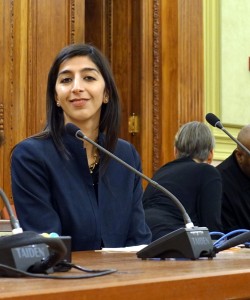
Good morning, Committee members. My name is Layla Moughari. I am a resident of Ward One and a member .of the Stop Street Harassment Board of Directors. Thank you for the opportunity to speak at this roundtable.
I’m here to request that you take action against street harassment.
Many people see street harassment as harmless, and a fact of life. But street harassment can be terrifying and inhibit mobility, and there’s always a possibility that street harassment can escalate into violence or sexual assault.
In the 10 years I’ve lived in DC, street harassment has been a regular feature in my life. There have been times I’ve experienced it daily.
In Columbia Heights, I’ve experienced several aggressive and upsetting interactions. On one occasion, two men shouted obscenities at me because I didn’t respond to their advances. Another time, someone grabbed me as he rode past me on his bike.
And in another situation I was alone, walking to the gym at 6 o’clock in the morning. It was pitch black out and no one was around. I heard someone hissing at me. I looked around and couldn’t see anyone. The hissing continued but closer this time. I realized that someone was following me, getting closer to me, but hiding from me. I was alone in the dark. When the hissing continued, I felt that I was in imminent danger and completely helpless. I started to run and scream down the street. A concerned neighbor asked if I was OK. I was still scared, but I felt better instantly.
I skipped the gym that morning, and never felt safe walking home again. In fact, the harassment I experienced in Columbia Heights contributed to my decision to move from the neighborhood in 2012 after living there five years.
Unfortunately, this experience is not unique to me as is evident by the others here today and the many people who submit their stories to the CASS and Stop Street Harassment blogs. A national study commissioned by SSH found that two-thirds of women and one-quarter of men had experienced gender-based harassment in public spaces.
While some research exists on street harassment, we lack concrete data for DC and are limited in what we know about the rates, causes and consequence of street harassment here in the District, as well as the best practices for combating it.
I request that the city council assist in collecting data so we can better understand the scope of the problem and where specifically it happens. Then, once we understand the issue more, I hope the city council can work with local organizations on non-criminalizing, community-based solutions such as public awareness campaigns.
I hope that one day street harassment will be viewed the same way workplace sexual harassment is largely seen now, recognized by our culture as disrespectful, inappropriate, and harmful. Workplace sexual harassment was also accepted as normal not long ago. But with research, policies, laws, enforcement of the rule of law, and culture change, workplace harassment is much less pervasive today.
#16Days of Activism: Making Businesses Safer (Day 11)
Nov. 25 – Dec. 10 are the 16 Days of Activism Against Gender-Based Violence. To commemorate the week, we are featuring 1 activism idea per day. This information is excerpted from my new book Stop Global Street Harassment: Growing Activism Around the World (Praeger 2015).
In the United States, a few advocacy groups have worked with businesses to make safer spaces for customers and community members. In 2011 in Arizona, the Southern Arizona Center Against Sexual Assault, for instance, launched Safe Streets AZ to address street harassment, particularly harassment targeted at LGBTQ youth. One component of the campaign is Safe Sites. Staff at restaurants, bookstores, and coffee shops take a 30-minute Safe Sites training, which then allows the establishment to be listed as a place where youth can seek safety if they are facing street harassment or feel unsafe. Nearly 30 businesses have gone through the training, and it is endorsed by the Pima County Small Business Commission, the Southern Arizona Chamber of Commerce Alliance, and the Pima County Public Libraries. Each site is listed on a Google map on the Safe Streets AZ website.
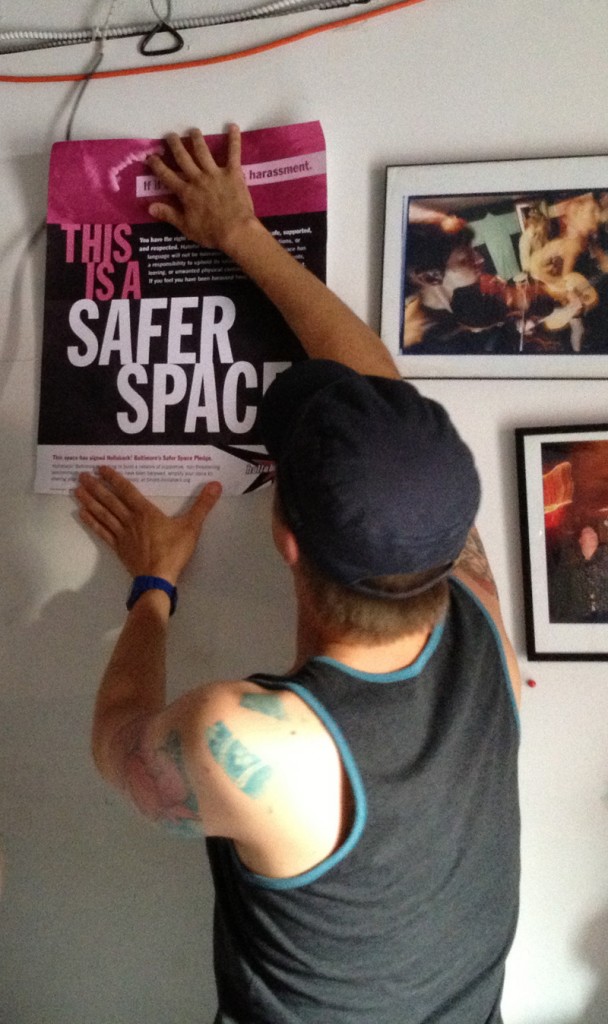 Inspired by the Good Night Out campaign in London, the members of Baltimore’s Hollaback! Bmore launched a Safer Spaces Campaign in 2013. They work directly with a business to ensure its current employee guide and/or security policies are comprehensive and sensitive to experiences of gender-based violence. Then Hollaback! Bmore provides a free training workshop on street harassment basics and crisis response that includes role-playing real-life situations. Once a majority of employees have gone through the training, they sign a pledge, hang an informational poster (provided) in plain view, and receive the Hollaback! Employer’s Guide to Ending Street Harassment. Hollaback! Bmore then supports and advertises these spaces on its website. So far, eight venues are completely trained, two are being scheduled, and 14 more have expressed interest.
Inspired by the Good Night Out campaign in London, the members of Baltimore’s Hollaback! Bmore launched a Safer Spaces Campaign in 2013. They work directly with a business to ensure its current employee guide and/or security policies are comprehensive and sensitive to experiences of gender-based violence. Then Hollaback! Bmore provides a free training workshop on street harassment basics and crisis response that includes role-playing real-life situations. Once a majority of employees have gone through the training, they sign a pledge, hang an informational poster (provided) in plain view, and receive the Hollaback! Employer’s Guide to Ending Street Harassment. Hollaback! Bmore then supports and advertises these spaces on its website. So far, eight venues are completely trained, two are being scheduled, and 14 more have expressed interest.
Help fund our work in 2016, donate to our end-of-year giving campaign!
Street Harassment Testimony Before DC Council – Kearl
Yesterday the DC council held an historic hearing on street harassment. This was my testimony.
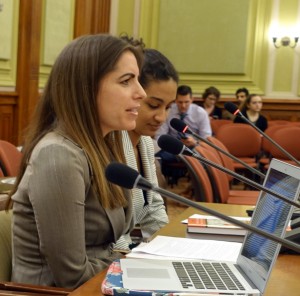 Good morning, members of the Committee on the Judiciary and the Committee on Housing & Community Development. My name is Holly Kearl. I am the founder of Stop Street Harassment, a consultant for UN Women’s Safe Cities Global Initiative and the author of several books about sexual harassment in public spaces, or street harassment.
Good morning, members of the Committee on the Judiciary and the Committee on Housing & Community Development. My name is Holly Kearl. I am the founder of Stop Street Harassment, a consultant for UN Women’s Safe Cities Global Initiative and the author of several books about sexual harassment in public spaces, or street harassment.
I’ve lived in the area for more than 10 years and across 8 of them, I was in DC daily for graduate school and then work. Like probably everyone in the room, I’ve personally experienced numerous instances of harassment here.
I am thrilled this roundtable is taking place. Only three other city councils in the country have held sessions specifically on this topic: NYC in 2010, Philadelphia in 2013, and Kansas City in 2014.
Yet, street harassment is a pervasive problem across the nation. My organization commissioned the largest nationally representative survey to date last year and it found that 2/3rds of women and 1/4th of men had faced street harassment. Women mostly faced sexualized comments and nearly 1 in 4 reported being touched sexually in a public space.
For men, homophobic or transphobic slurs were most common. As part of the research, I also conducted focus groups nationwide, including one with gay and bisexual men in Washington, DC, many of whom shared numerous harassment stories.
For most people who took the survey, street harassment began before age 17. This is not okay.
Addressing street harassment matters because it makes people feel unsafe, objectified, and uncomfortable in public spaces. It can limit people’s lives in significant ways, including where they go, when, with whom and what they do.
For this reason, a growing number of governments as well as the United Nations view street harassment as a human rights violation and something that prevents full equality.
I am grateful that Washington, DC leaders are acknowledging this too, most notably, on the transit system. Nearly four years ago, I testified about harassment before the city council during WMATA’s performance oversight hearing. I am glad that WMATA quickly agreed to begin tracking incidents, train their staff, and create PSAs. I can’t help but smile each time I see a poster on the system.
We join other capital cities who have recently launched transit campaigns in London, Paris, Tokyo, Delhi, Cairo and Bogota and in American cities like Los Angeles, Boston, Philadelphia, and NYC.
WMATA has committed to another PSA campaign next year, for which I’m grateful. We’ve discussed having its message focus on encouraging bystanders to speak up. For a first recommendation today, I want to emphasize the importance of bystanders being the focus.
Bystander intervention is important for many reasons and one is that it can help a harassed person get through a terrible situation more easily. I have heard over and over from women who say that an experience was so much worse because there were people all around when the harassment happened but no one said or did anything. If they are taught what to do, bystanders may be able to interrupt or stop the harassment, or at the very least, check in with the harassed person to see if they are okay and thus help them recover more quickly from what happened.
Harassment of course, is not limited to the transit system. It also happens on the streets, in parks, in bars and clubs, and in stores and restaurants. For that reason, my second recommendation is that the city council work with local groups like CASS and SSH on collecting data so we can better understand the problem and work to end it, using community-based, non-criminal solutions.
And last, because many people feel alcohol or the relaxed atmosphere of a bar or club makes inappropriate behavior okay, I would also suggest a special focus on addressing harassment there. A few cities have campaigns to train bar and club staff about harassment, including Boston and Iowa City and the whole state of Arizona. In the UK, the Good Night Out campaign works nationally with more than 100 night life venues.
Locally, CASS and Defend Yourself have a Safe Bars program and I hope the city council can help give local establishments incentives to work with them.
I am proud to live in an area where street harassment is taken seriously and I look forward to collaborating and working with the city council in the future. Thank you.
